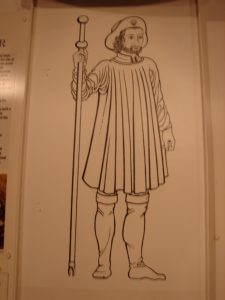Worcester, England, is the setting for King Richard’s Sword, the sixth novel in my Lady Apollonia West Country Mysteries. This book, still in preparation, takes place in 1399-1400, and I hope to have it out before the end of the year. Watch this blog for further details.
One of my new characters in this book is Robert Kenwood, inspired by a real life person known as the Worcester Pilgrim. In 1987, during the course of excavations carried out to examine the foundations of the Central Tower of Worcester Cathedral, a grave was discovered close to the South-Eastern Tower pier. The burial contained the remains of a man who had been wearing knee-length boots and woollen upper garments. Remains of a staff lay by his side and a small shell, possibly a pilgrim badge, was found nearby. Numerous examples of medieval pilgrim burials with staff and scallop shell indicating an accomplished pilgrimage to Santiago de Compostela in Northern Spain have been excavated in Europe, but this was the first to be discovered in England. Scientific analysis of the pilgrim’s skeleton revealed that he was a robust, thick-set man, about five feet seven and a half inches tall. He had clearly walked very long distances, and the development of his right hand, arm and shoulder showed that he made good use of his staff. At some time during his travels, he seemed to have been wounded by arrows in his left leg and hip. His clothing portrayed him as a man of some wealth, but probably not noble.
I have made the pilgrim, Robert Kenwood, into a wealthy merchant of Worcester who returns from pilgrimage in the prologue of the book and becomes a dear friend to the Lady Apollonia of Aust.
A drawing of the Worcester Pilgrim, pictured below, is on display in the crypt of Worcester Cathedral.
Tags: Chaucer's England, historical fiction, medieval mysteries